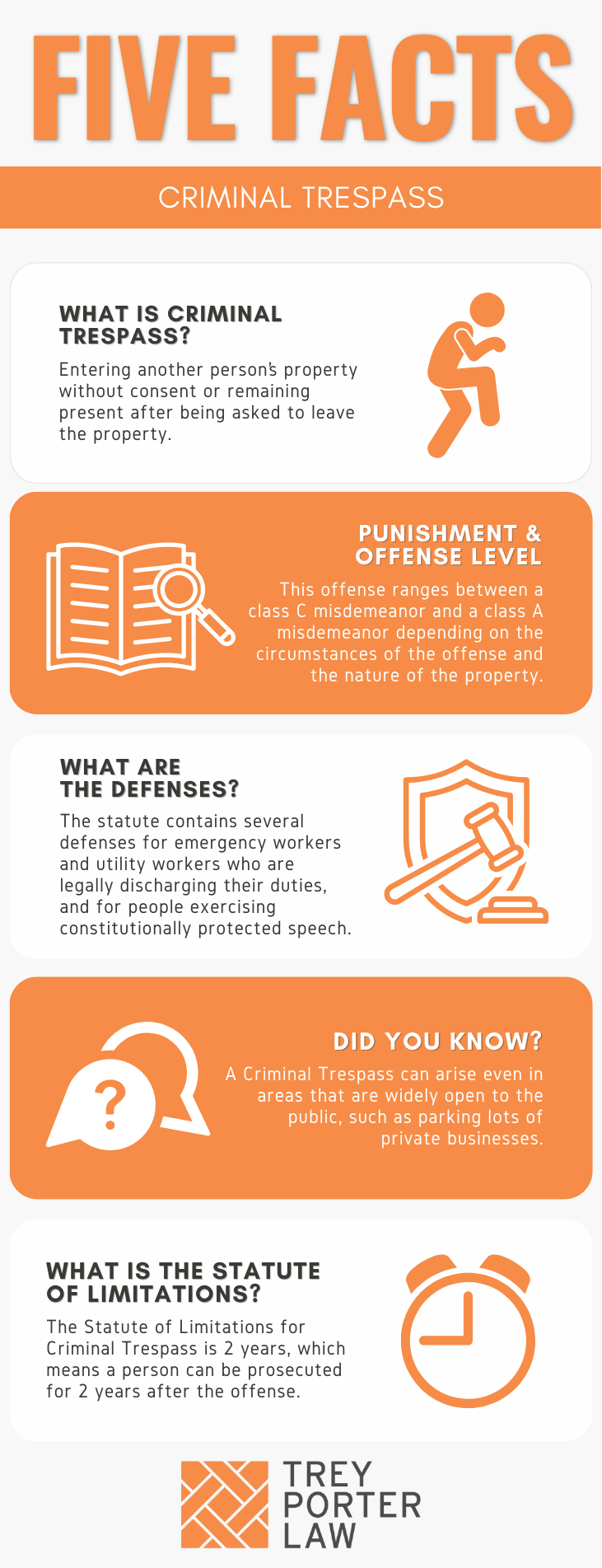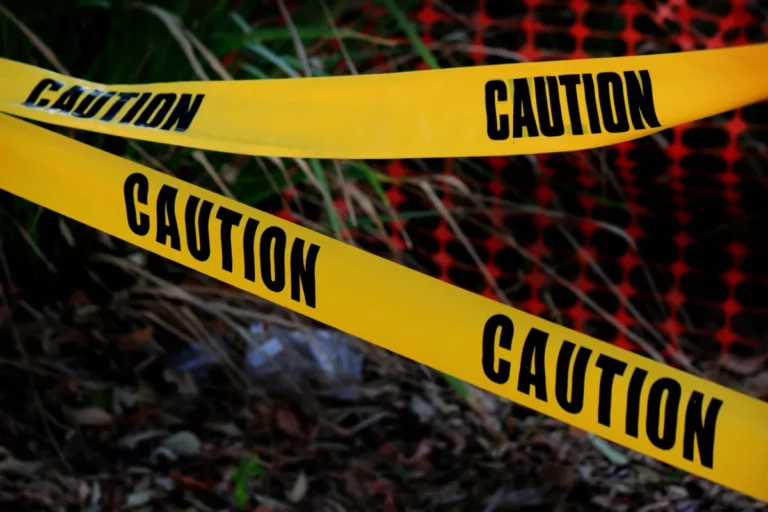WHAT IS CRIMINAL TRESPASS IN TEXAS?
Criminal trespass is entering another’s property without consent, or remaining on or in another’s property after being told to leave.
- What “entry” is required to be charged with criminal trespass? eTexas Penal Code Section 30.05 defines “entry” as “the intrusion of the entire body.” The Court of Criminal Appeals observed in State v. Meru that the criminal trespass law requires a person to enter a location completely, while the entry punished by Texas burglary statute includes the intrusion of “any part of the body,” or “any physical object connected with the body.”

WHAT IS THE CRIMINAL TRESPASS LAW IN TEXAS?
Tex. Penal Code § 30.05. CRIMINAL TRESPASS.
(a) A person commits an offense if the person enters or remains on or in property of another, including residential land, agricultural land, a recreational vehicle park, a building, a general residential operation operating as a residential treatment center, or an aircraft or other vehicle, without effective consent and the person:
(1) had notice that the entry was forbidden; or
(2) received notice to depart but failed to do so.
. . .
(c) A person may provide notice that firearms are prohibited on the property by posting a sign at each entrance to the property that:
(1) includes language that is identical to or substantially similar to the following: “Pursuant to Section 30.05, Penal Code (criminal trespass), a person may not enter this property with a firearm”;
(2) includes the language described by Subdivision (1) in both English and Spanish;
(3) appears in contrasting colors with block letters at least one inch in height; and
(4) is displayed in a conspicuous manner clearly visible to the public.
(d) Subject to Subsection (d-3), an offense under this section is:
(1) a Class B misdemeanor, except as provided by Subdivisions (2) and (3);
(2) a Class C misdemeanor, except as provided by Subdivision (3), if the offense is committed:
(A) on agricultural land and within 100 feet of the boundary of the land; or
(B) on residential land and within 100 feet of a protected freshwater area; and
(3) a Class A misdemeanor if:
(A) the offense is committed:
(i) in a habitation or a shelter center;
(ii) on a Superfund site; or
(iii) on or in a critical infrastructure facility;
(B) the offense is committed on or in property of an institution of higher education and it is shown on the trial of the offense that the person has previously been convicted of:
(i) an offense under this section relating to entering or remaining on or in property of an institution of higher education; or
(ii) an offense under Section 51.204(b)(1), Education Code, relating to trespassing on the grounds of an institution of higher education;
(C) the person carries a deadly weapon during the commission of the offense; or
(D) the offense is committed on the property of or within a general residential operation operating as a residential treatment center.
(d-1) For the purposes of Subsection (d)(3)(B), a person has previously been convicted of an offense described by that paragraph if the person was adjudged guilty of the offense or entered a plea of guilty or nolo contendere in return for a grant of deferred adjudication community supervision, regardless of whether the sentence for the offense was ever imposed or whether the sentence was probated and the person was subsequently discharged from deferred adjudication community supervision.
(d-2) At the punishment stage of a trial in which the attorney representing the state seeks the increase in punishment provided by Subsection (d)(3)(B), the defendant may raise the issue as to whether, at the time of the instant offense or the previous offense, the defendant was engaging in speech or expressive conduct protected by the First Amendment to the United States Constitution or Section 8, Article I, Texas Constitution. If the defendant proves the issue in the affirmative by a preponderance of the evidence, the increase in punishment provided by Subsection (d)(3)(B) does not apply.
(d-3) An offense under this section is a Class C misdemeanor punishable by a fine not to exceed $200 if the person enters the property, land, or building with a firearm or other weapon and the sole basis on which entry on the property or land or in the building was forbidden is that entry with a firearm or other weapon was forbidden, except that the offense is a Class A misdemeanor if it is shown on the trial of the offense that, after entering the property, land, or building with the firearm or other weapon, the actor:
(1) personally received from the owner of the property or another person with apparent authority to act for the owner notice that entry with a firearm or other weapon was forbidden, as given through:
(A) oral or written communication by the owner or someone with apparent authority to act for the owner; or
(B) if the actor is unable to reasonably understand the notice described by Paragraph (A), other personal notice that is reasonable under the circumstances; and
(2) subsequently failed to depart.
(e) It is a defense to prosecution under this section that the actor at the time of the offense was:
(1) a firefighter or emergency medical services personnel acting in the lawful discharge of an official duty under exigent circumstances;
(2) a person who was:
(A) an employee or agent of:
(i) an electric utility, as defined by Section 31.002, Utilities Code;
(ii) a telecommunications provider, as defined by Section 51.002, Utilities Code;
(iii) a video service provider or cable service provider, as defined by Section 66.002, Utilities Code;
(iv) a gas utility, as defined by Section 101.003, Utilities Code, which for the purposes of this subsection includes a municipally owned utility as defined by that section;
(v) a gas utility, as defined by Section 121.001, Utilities Code;
(vi) a pipeline used for the transportation or sale of oil, gas, or related products; or
(vii) an electric cooperative or municipally owned utility, as defined by Section 11.003, Utilities Code; and
(B) performing a duty within the scope of that employment or agency; or
(3) a person who was:
(A) employed by or acting as agent for an entity that had, or that the person reasonably believed had, effective consent or authorization provided by law to enter the property; and
(B) performing a duty within the scope of that employment or agency.
(f) It is a defense to prosecution under this section that:
(1) the basis on which entry on the property or land or in the building was forbidden is that entry with a handgun was forbidden; and
(2) the person was carrying:
(A) a license issued under Subchapter H, Chapter 411, Government Code, to carry a handgun; and
(B) a handgun:
(i) in a concealed manner; or
(ii) in a holster.
(f-1) It is a defense to prosecution under this section that:
(1) the basis on which entry on the property was forbidden is that entry with a firearm or firearm ammunition was forbidden;
(2) the actor is:
(A) an owner of an apartment in a condominium regime governed by Chapter 81, Property Code;
(B) an owner of a condominium unit governed by Chapter 82, Property Code;
(C) a tenant or guest of an owner described by Paragraph (A) or (B); or
(D) a guest of a tenant of an owner described by Paragraph (A) or (B);
(3) the actor:
(A) carries or stores a firearm or firearm ammunition in the condominium apartment or unit owner’s apartment or unit;
(B) carries a firearm or firearm ammunition directly en route to or from the condominium apartment or unit owner’s apartment or unit;
(C) carries a firearm or firearm ammunition directly en route to or from the actor’s vehicle located in a parking area provided for residents or guests of the condominium property; or
(D) carries or stores a firearm or firearm ammunition in the actor’s vehicle located in a parking area provided for residents or guests of the condominium property; and
(4) the actor is not otherwise prohibited by law from possessing a firearm or firearm ammunition.
(f-2) It is a defense to prosecution under this section that:
(1) the basis on which entry on a leased premises governed by Chapter 92, Property Code, was forbidden is that entry with a firearm or firearm ammunition was forbidden;
(2) the actor is a tenant of the leased premises or the tenant’s guest;
(3) the actor:
(A) carries or stores a firearm or firearm ammunition in the tenant’s rental unit;
(B) carries a firearm or firearm ammunition directly en route to or from the tenant’s rental unit;
(C) carries a firearm or firearm ammunition directly en route to or from the actor’s vehicle located in a parking area provided for tenants or guests by the landlord of the leased premises; or
(D) carries or stores a firearm or firearm ammunition in the actor’s vehicle located in a parking area provided for tenants or guests by the landlord of the leased premises; and
(4) the actor is not otherwise prohibited by law from possessing a firearm or firearm ammunition.
(f-3) It is a defense to prosecution under this section that:
(1) the basis on which entry on a leased premises governed by Chapter 94, Property Code, was forbidden is that entry with a firearm or firearm ammunition was forbidden;
(2) the actor is a tenant of a manufactured home lot or the tenant’s guest;
(3) the actor:
(A) carries or stores a firearm or firearm ammunition in the tenant’s manufactured home;
(B) carries a firearm or firearm ammunition directly en route to or from the tenant’s manufactured home;
(C) carries a firearm or firearm ammunition directly en route to or from the actor’s vehicle located in a parking area provided for tenants or tenants’ guests by the landlord of the leased premises; or
(D) carries or stores a firearm or firearm ammunition in the actor’s vehicle located in a parking area provided for tenants or tenants’ guests by the landlord of the leased premises; and
(4) the actor is not otherwise prohibited by law from possessing a firearm or firearm ammunition.
(f-4) It is a defense to prosecution under this section that:
(1) the conduct occurred on hotel property, and the basis on which entry on that property was forbidden is that entry with a firearm or firearm ammunition was forbidden;
(2) the actor is a guest of a hotel, as defined by Section 2155.101, Occupations Code; and
(3) the actor:
(A) carries or stores a firearm or firearm ammunition in the actor’s hotel room;
(B) carries a firearm or firearm ammunition directly en route to or from the hotel or the actor’s hotel room;
(C) carries a firearm or firearm ammunition directly en route to or from the actor’s vehicle located on the hotel property, including a vehicle in a parking area provided for hotel guests; or
(D) carries or stores a firearm or firearm ammunition in the actor’s vehicle located on the hotel property, including a vehicle in a parking area provided for hotel guests.
(g) It is a defense to prosecution under this section that the actor entered a railroad switching yard or any part of a railroad switching yard and was at that time an employee or a representative of employees exercising a right under the Railway Labor Act (45 U.S.C. Section 151 et seq.).
(h) At the punishment stage of a trial in which the attorney representing the state seeks the increase in punishment provided by Subsection (d)(3)(A)(iii), the defendant may raise the issue as to whether the defendant entered or remained on or in a critical infrastructure facility as part of a peaceful or lawful assembly, including an attempt to exercise rights guaranteed by state or federal labor laws. If the defendant proves the issue in the affirmative by a preponderance of the evidence, the increase in punishment provided by Subsection (d)(3)(A)(iii) does not apply.
(i) This section does not apply if:
(1) the basis on which entry on the property or land or in the building was forbidden is that entry with a handgun or other weapon was forbidden; and
(2) the actor at the time of the offense was a peace officer, including a commissioned peace officer of a recognized state, or a special investigator under Article 2.122, Code of Criminal Procedure, regardless of whether the peace officer or special investigator was engaged in the actual discharge of an official duty while carrying the weapon.
WHAT IS THE PENALTY CLASS FOR CRIMINAL TRESPASS IN TEXAS?
By default, criminal trespass is a Class B misdemeanor, punishable by up to 180 days in county jail.
Criminal trespass is a Class A misdemeanor, punishable by up to one year in county jail, if the person carries a deadly weapon while trespassing, or the trespass location is a:
- “habitation,” or home;
- Superfund site on the National Priorities List or state registry;
- critical infrastructure facility, unless the person was participating in “a peaceful or lawful assembly,” in which case the trespass remains a Class B misdemeanor;
- college, university, or other institution of higher education, and the person has previously been convicted of trespassing onto property of the same character, unless the accused shows by a preponderance of the evidence the trespass was for engaging in expressive speech or conduct protected by the First Amendment;
- residential treatment center.
Criminal trespass is a Class C misdemeanor, punishable by a maximum fine of $500, if a person trespasses onto agricultural land within 100 feet of the boundary, or on residential land within 100 feet of a protected freshwater area.
Texas law increases the penalty classification for criminal trespass to the next highest category, or to minimum confinement of 180 days in jail for a Class A misdemeanor, if a person commits the offense in an area subject to an emergency evacuation order, or under a declaration of a state of disaster by the governor or president of the United States. See Tex. Penal Code § 12.50.
Texas Penal Code Section 12.501 increases the penalty classification to the next highest category if the offense is committed against a public servant, a member of the public servant’s family or household, or property owned or controlled by a public servant, in retaliation for or on account of the public servant’s status.
- Can a person be charged with criminal trespass based on carrying a firearm? Yes. Texas Penal Code Section 30.05(c) permits private businesses and other property owners to post conspicuous warning signs that carrying firearms on premises is forbidden. If the sole basis for the criminal trespass charge is entry onto such property with a firearm or other weapon, it is a Class C misdemeanor, punishable by a reduced maximum fine of $200.However, if the person in possession of the firearm is told by the owner or other person with authority to leave, and the person refuses to leave, the trespass charge becomes a Class A misdemeanor. Peace officers and other law enforcement cannot be prohibited from carrying a firearm under the criminal trespass statute.
WHAT IS THE PUNISHMENT RANGE FOR CRIMINAL TRESPASS IN TEXAS?
Class C misdemeanors are only punishable by a fine of up to $500. However, if a person is charged with criminal trespass with a firearm as a Class C misdemeanor, the maximum fine is $200. Criminal trespass charged as a Class B misdemeanor carries up to 180 days in jail, and a maximum fine of $2,000. A person charged with Class A misdemeanor criminal trespass faces up to one year in jail, and a maximum fine of $4,000.
WHAT ARE THE PENALTIES FOR CRIMINAL TRESPASS IN TEXAS?
A person charged with a Class C misdemeanor criminal trespass is eligible for deferred adjudication for a maximum period of 180 days. If convicted, the person will only be required to pay the fine assessed, without being subjected to probation or further conditions.
A person charged with a Class A or Class B misdemeanor criminal trespass is eligible for probation after a conviction, or deferred adjudication to avoid a conviction, for up to two years.
WHAT ARE THE DEFENSES TO CRIMINAL TRESPASS IN TEXAS?
Statutory defenses exist for firefighters, emergency personnel, and utility workers performing official duties, and for railroad switching yard employees or representatives of employees who enter a switching yard in exercise of a right under the Railway Labor Act.
Additional defenses are authorized if the sole basis for the criminal trespass charge is entering the premises with a firearm, despite signs posted forbidding firearm possession.
- Can hotels, apartment and condominium complexes, and manufactured home communities prohibit firearm possession on premises? Yes, but the law creates several defenses, so an ultimate conviction is unlikely. A person who ignores a firearm prohibition may be arrested for a Class C misdemeanor. However, tenants and hotel guests may attempt to show they merely stored the firearm in their room or unit, were carrying the firearm directly to or from their room or unit to their vehicle, or stored it in their vehicle on the property.
- Does a license to carry protect a person from criminal charges for firearm possession in Texas? Yes, under certain circumstances. Holders of a license to carry a handgun arrested for criminal trespass by carrying a gun onto property prohibiting firearms may raise a defense if they show the gun was either holstered, or concealed while on the property. However, if license holders are notified handguns are prohibited on property, even for those with a license to carry, they may still be punished under Texas Penal Code Sections 30.06 or 30.07 if they refuse to leave.
- Is a criminal trespass warning required before a person is charged with criminal trespass? The law only requires notice that entry is forbidden, or that a person must depart from the location. Notice includes any oral or written communication by someone with authority, a fence or other enclosure designed to exclude intruders, or signs on the property.In Salazar v. State, the Court of Criminal Appeals held society has inherent notice of forbidden entry into another’s habitation. For locations generally open to the public, a written criminal trespass warning is one way to give notice, but is not required, as long as a person was told to leave and not return by someone authorized to do so.
- Does the First Amendment protect freedom of speech and assembly in locations open to the public? The criminal trespass statute recognizes certain defenses for peaceful protests, and other expressive conduct. For example, those charged with Class A misdemeanor criminal trespass onto college or university grounds, or onto a critical infrastructure, may show they were engaging in protected speech or expressive conduct to reduce their punishment to a Class B misdemeanor range. But the First Amendment protections are not limitless.
- What are the risks of trespassing in Texas? Texas Penal Code Sections 9.41 and 9.42 permit victims of crimes such as burglary and criminal trespass to use force, including deadly force, in defense of property.
WHAT IS THE STATUTE OF LIMITATIONS FOR CRIMINAL TRESPASS IN TEXAS?
The limitation period for criminal trespass is two years.
CRIMINAL TRESPASS IN TEXAS
Texas law prohibits entering another’s property without permission, or remaining on another’s property after being told to leave.
TEXAS CRIMINAL TRESPASS COURT CASES
The case law regarding criminal trespass in Texas illustrates the statute’s constitutionality.
In Zarsky v. State, the defendant participated in an anti-abortion protest. He stood in the parking lot of a clinic in an office complex, eight feet from the front door. The office complex owner told the defendant to leave, but he refused. Shortly thereafter, he was arrested for criminal trespass, and subsequently convicted. The appellate court affirmed, rejecting his First Amendment claim. And just because the business was “open to the public” does not mean it assumed the functional attributes of public property devoted to public use.
















